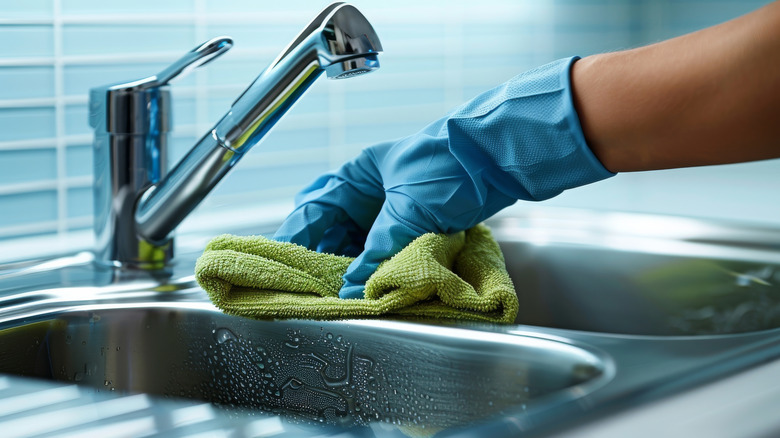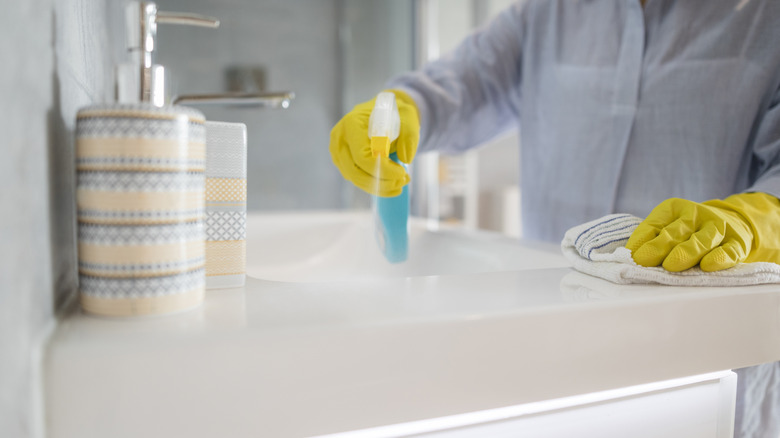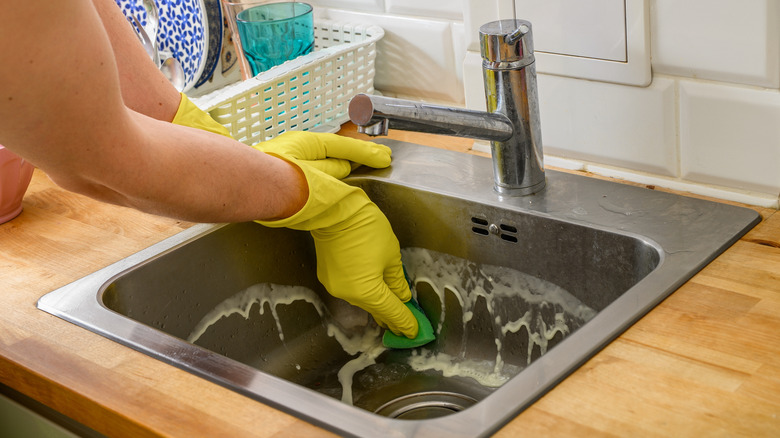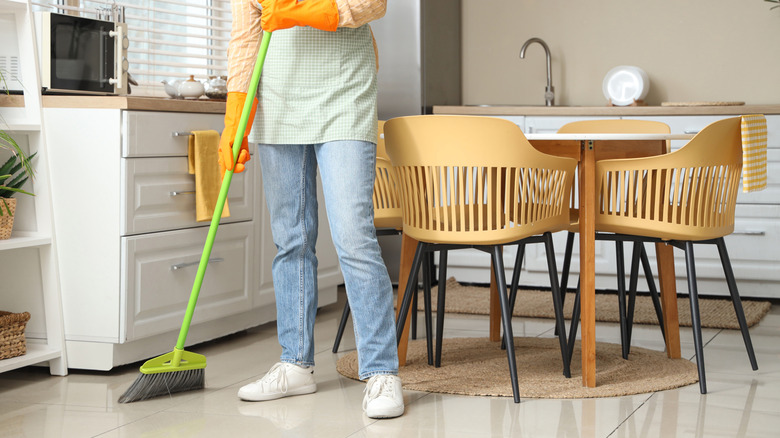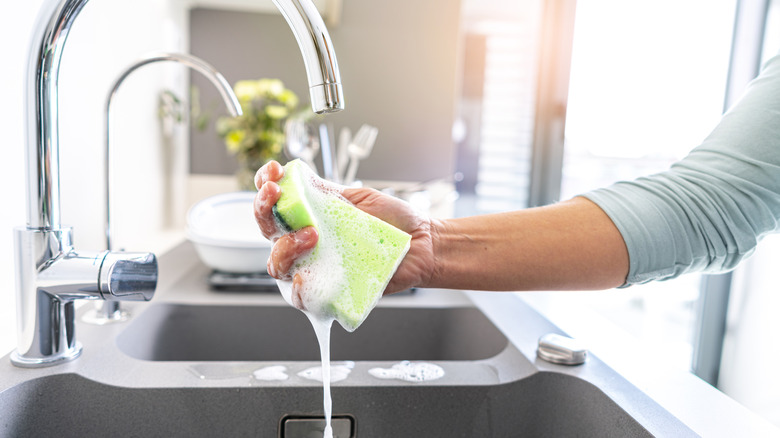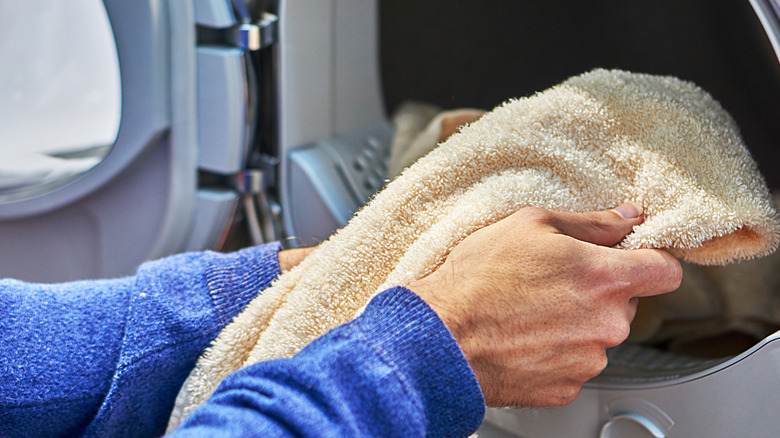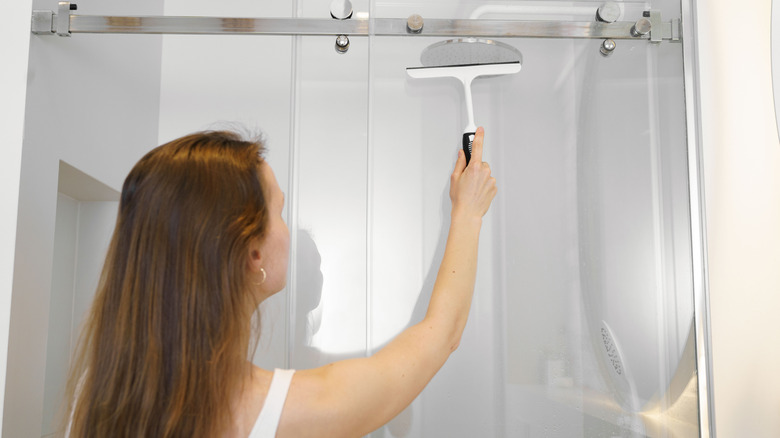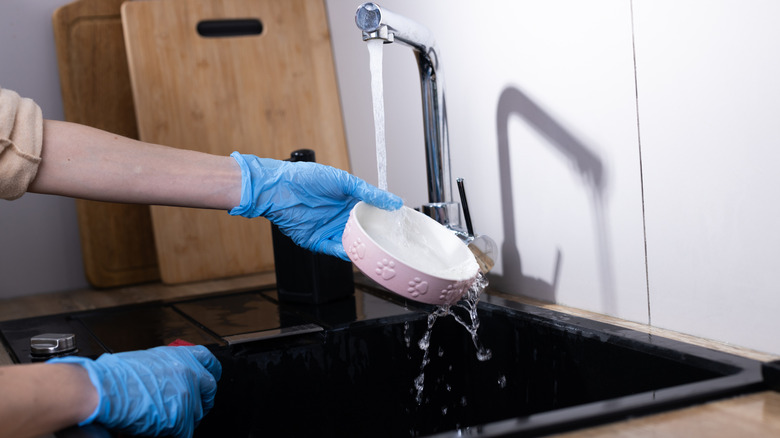You Should Be Cleaning These 10 Things In Your House Every Day
We may receive a commission on purchases made from links.
While all-out cleaning sessions can definitely be left to the weekends, there are certain tasks, surfaces, and areas that require a daily sanitation session. The idea of cleaning something every day probably feels pretty tedious even to the most hygienic-minded homebody, but trust us, there are some spots you can't ignore if you want them germ-free. And you won't have to spend a ton of time on these light cleaning tasks. Roughly 30-60 minutes should be enough to knock them off your list.
Besides maintaining hygiene levels, a quick daily clean of key areas can also help prevent bigger jobs down the line. For instance, if you wipe shower walls immediately after use, this will prevent soap scum and hard water spots from building up into a tough-to-budge deposit and help keep mildew away. Similarly, cleaning your kitchen sink daily won't just keep it shiny and bacteria-free — it might also mean fewer of those painfully stubborn hardwater marks. On the other hand, disinfecting your smartphones and washing your pet's food bowl every day might not save you from big deep cleaning jobs during the weekend, but they sure will increase crucial cleanliness levels.
Ready to get started? Here are 10 things in your house you should be cleaning every day. And, just for the record, you don't have to cram them all into your daily routine in one go. Start small if you feel overwhelmed and take on more chores as and when you feel comfortable.
Wipe your bathroom countertop after use to prevent nasty buildup
Although having a roomy bathroom countertop with lots of real estate for personal care products can be incredibly convenient, you must wipe it daily to prevent nasty buildup. Otherwise, rogue toothpaste flecks, stray hair, soap scum, makeup residue, and water droplets will build up over time. Add dust into the mix, and your bathroom will look and feel untidy. Some messes might even stain the surface. Moreover, your counter may become a breeding ground for bacteria. And if your vanity can't withstand water for long, it could sustain permanent damage, like warping.
So, make it a point to wipe your vanity counter every day. Swipe up any hair and drop it in the trash. Then, dampen a clean microfiber cloth and run it over the splatters to clean your vanity top. Keep a microfiber cloth under your sink to make daily cleanup easier. If you're dealing with stubborn spots on a quartz or porcelain surface, dunk the cloth in warm water and a mild dish soap solution to get rid of them. However, you'll need a pH-neutral cleaning solution, like Stone Care International's Granite and Stone Daily Cleaner, for marble, granite, and other natural stone countertops — as strong acids and alkalis can dull the surface and trigger surface-level damage, a.k.a. etching.
Keep your kitchen sink from turning into a breeding ground for bacteria with a nightly scrub down
Your kitchen sink probably witnesses a lot, including cleaning hands, rinsing vegetables, washing raw meat, dishwashing, and dumping out stale coffee or tea. This can turn it into a breeding ground for bacteria. The USDA conducted a Food Safety Consumer Research Project in 2023 wherein participants made breakfast using raw sausage, shell eggs, and a cantaloupe (for fruit salad). Afterward, when researchers tested kitchen surfaces for cross-contamination, 37.5% of sinks tested positive (taking the first spot). Worse, the lingering bacteria in the sink and on the participants' hands from handling raw meat also latched onto the cantaloupe, with over 25% of them being contaminated. This is why it's important to clean your kitchen sink daily: Ideally every night or immediately after you wash meat if you don't want to consume harmful bacteria unknowingly, such as Salmonella and E.coli.
Start by donning your rubber gloves and fishing out any leftover food residue. Don't let it rot in your garbage disposal or clog up your drain stopper. Then, rinse it with warm water. Add a few drops of your favorite dish soap (if you're still searching for your HG option, here's a guide on the best dish detergents) and scrub it with disposable paper towels or a sponge, making sure to include the sides and lip for a thorough clean. You also want to go over your faucet and sprayer. Once you're satisfied, rinse your sink and faucet with clean water. This will get your sink area clean and free from greasy food residue, but if you want to thoroughly sanitize the area to totally minimize risks of cross-contamination — then you'll need to use something stronger. You can either wipe down your sink with a store-bought sanitizing solution, sanitizing wipes (like the Clorox Disinfecting Wipes) or make your own by mixing 1 tablespoon of liquid chlorine bleach in 1 gallon of water. Don't forget to wash your sponge and gloves after, and don't leave them in the sink to dry as they can turn into yet another moist breeding place for bacteria.
Give your kitchen floors a quick after-dinner clean to keep pests away
Unless you have a very high-traffic home, it's probably not necessary to sweep or vacuum your floors more than a couple of times per week. But, there's one exception: your kitchen floor. Dropped food, accidental spills, and leftover crumbs can get trodden in, and if ignored, the greasy spots and debris will become one with the surface and be harder to clean. Food residue and crumbs left overnight can also turn your floor into a buffet zone for rodents and roaches. So, if you use your kitchen every day (even if it's just for simple food prep tasks), sweeping after the last meal will ensure crumbs, bits of food, and other nasties don't linger overnight.
Fortunately, cleaning your kitchen floor daily can be a quick operation. If there's just a few crumbs scattered around, simply grab the broom and run it over your floors. Gather all the debris in one spot and use a dustpan to dispose of it. If you're not a big fan of bending, give your back a break with kelamayi's Long Handle Broom and Dustpan Set or fire up your vacuum instead. Having a small cordless vacuum in or close to the kitchen for quick after-dinner floor cleanup can make the job even quicker, allowing you to zip over the space in a matter of moments. If the floor is sporting any spills, splatters, or stickiness, you might want to also give it a quick mop or once-over with a Swiffer. Although this routine will add to your nightly regime, this one daily task in your kitchen will ease back your weekly cleaning.
Clean your toilet's exterior daily, especially if multiple people share it
It's no secret that toilets harbor a lot of germs, but a weekly or bi-weekly cleanup is often enough to maintain a hygienic environment. However, exactly how often you should clean your toilet depends very much on the number of people using it — and how they use it. If a toilet is shared by multiple people, especially ones who might accidentally miss the mark (such as kids and gents with an unpredictable aim), then it might need a quick daily cleaning. You should also clean it every day if you share it with elderly people, anyone with a compromised immune system, or if someone in the household is sick, as diarrhea or bouts of nausea will also expose you to bacteria.
Like the other daily cleaning tasks on this list, sanitizing your toilet shouldn't take a lot of time. All you have to do is wipe the toilet's exterior, like the seat, sides, and tank, to minimize exposure to lingering germs. Spray a little antibacterial cleaning solution, like Lysol's All Purpose Cleaner Spray, and wipe the surfaces clean with a microfiber cloth. Or, get a few bleach wipes to sanitize your toilet seat. If you don't want to use bleach, buy antibacterial wipes that can still kill most viruses and bacteria. Lysol's Disinfectant Wipes are a good option. Whichever option you choose, don't forget to wipe the flush handle for a germ-free toilet. In addition to this basic daily sanitizing session, you'll also want to clean and disinfect the bowl a few times per week. To nail this additional task, here are the 5 essential steps to cleaning your entire toilet the right way.
Clean your phones to keep them hygienic
On average, an American spends over five hours of their day using their phone (per research by Harmony Healthcare IT). In other words, we're swiping, scrolling, and touching our smartphone's screen hundreds or thousands of times in a day. Using sweaty hands during workouts, frantic typing, or doom scrolling over the toilet, and using sticky fingers while eating can all turn the glass surface into a veritable pool of germs. In fact, it might be harboring 10 times more bacteria than your toilet seat (yikes). The cherry on top? Viruses can remain on your screens for about 96 hours. Face oils and grease don't help matters, either. So, don't just sanitize these electronics after getting over the flu; clean them every day if you can.
Plug out your mobile phone, turn it off, and remove the case. Wipe it with a soft microfiber cloth to get rid of the fingerprints and hidden dust or debris. To simply lift grime, you can spray a dedicated cleaner, like io CLEAN's Screen Cleaner, on a fresh part of the cloth, and then wipe your phone again to eliminate the lingering dirt. EVEO's Streak-Free Electronic Wipes are another good alternative.
Besides giving your phone a general surface clean, you may also need to disinfect it — but this is where things get slightly tricky. While you want to be disinfecting your devices as often as possible for health purposes, you don't want to overdo it, as harsh substances like bleach can damage the surfaces of electronics. It's often advised to avoid disinfecting wipes while cleaning your electronics since they can impair the fingerprint-resistant coating on your phone's exterior. However, Apple states that its devices can be cleaned with alcohol-based or Chlorox disinfecting wipes, and Samsung states that you can use a cloth dipped in 70% isopropyl alcohol. To be on the safe side, check the cleaning and disinfecting instructions from your device manufacturer.
Disinfect dishwashing sponges daily so they don't become one of the germiest things in your home
Dishwashing sponges are responsible for scrubbing your crockery and cookware clean, and they might be hiding more germs than you think. NSF's Germiest Places in the Home study revealed that these scrubbers are the filthiest object in a house, with 75% of the ones tested hiding disease-causing bacteria like Salmonella and E. coli. Think about it. These tiny cleaning tools remain damp for the better part of a day. Throw in food residue, and it's the ideal playground for bacteria to breed and thrive. Mold and yeast won't be too far behind. Sanitizing your sponges every day ensures that you're not inadvertently spreading potential pathogens while wiping surfaces and washing dishes.
One of the easiest ways to disinfect a sponge is to microwave it for 1-2 minutes daily. Soak it so it's wet, or it might go up in flames. Then place the sponge in a microwave-safe container and select the high setting. The steam produced during the process will eliminate 99.99999% of bacteria and make it safe for cleaning your dishes. But don't forget to let the sponge cool before touching it with your bare hands. Of course, don't try this method for metallic sponges since the resulting sparks can harm your microwave. To disinfect metallic scrubbers, put them in your dishwasher beside your dirty dishes. Choose the "heated dry" setting to kill 99.9998% of bacteria. Along with this daily practice, replace your sponges every week or two (or sooner if they smell bad or look worn), and immediately after they come into contact with raw meat or blood.
Switch out the hand towels in your bathroom each day to keep bacteria away
There's nothing worse than touching a limp, damp hand towel that someone else has just used — and drying your face with a stale one is arguably even worse. Less-than-fresh hand towels don't just feel icky, they're also unhygienic. Every time you use your bathroom hand towel, you're likely transferring bacteria (including fecal strains) and other germs from your skin to the absorbent cloth. These microorganisms can breed rapidly in your bathroom's humid, poorly ventilated, and dark environment. Moreover, musty hand towels can also house molds and yeasts. As a result, your hand towels might harbor more bacteria than your toilet within two days — which makes swapping in a clean hand towel every day a great practice. This is especially important if your hand towels see a lot of use. For instance, if all your family members and guests are using the same one to dry their hands after going to the toilet, they should be switched out daily.
To get the dirty ones sanitary, launder them separately in a towel load. Towels can cover your other garments in lint, and you don't want the towels to spread bacteria to clothing items, or pick up the strains from your dirty socks or underwear. Also, run smaller loads for a better clean, picking the long wash cycle and pairing it with warm to hot water. Also, don't add more detergent than necessary since towels can absorb the excess and feel rough. Don't use fabric softeners, too, since they will interfere with your hand towels' absorbency. Let them dry completely before storing them away.
Run a squeegee over your shower walls and door after every use
Although you can get away with just cleaning your shower weekly, it can be a back-breaking task if you don't maintain it on a daily basis. This is because soap scum will build up over time on your shower walls and door. And if you have hard water, limescale deposits will dull their appearance — especially glass doors (as compared to fiberglass). Grout that's left wet will also encourage mildew to set up shop. This, in turn, will entice mold to establish a stronghold. So, to keep your shower looking new, hang a squeegee nearby and run it over its walls and door after every use. Many models, like Hiware's All-Purpose Shower Squeegee, come with waterproof adhesive hooks or suction cups to make installation easier.
Start with your shower door to keep magnesium or calcium stains away. Position the squeegee at the top and move it in a "S" shape to swiftly remove leftover water. If you find this hard, just move the squeegee from the top to the bottom in straight lines. Then, start on your walls. Apply a similar strategy to dry them. Don't ignore built-in storage nooks since you don't want to leave water behind. The same goes for awkward corners. If you can't maneuver in tight spots, use a microfiber cloth instead. To avoid deep cleaning your shower often, combine distilled white vinegar and water (distilled would be best) in a spray bottle. Spritz it over your doors and walls and let them air dry. Avoid spraying the acidic solution on marble, granite, or slate walls (for these you can use something like Granite Gold's Shower Cleaner Spray).
Lightly clean your coffee maker daily to keep enjoying delicious cups
If you don't resemble a human until that first cup of coffee, chances are you brew a pot every day. But if you don't rinse your coffee maker right after or once a day, residual coffee, milk, and oils can build up. This will alter the taste of your coffee and make the eventual deep cleaning more time- and effort-consuming. Leftover water in the reservoir can also provide the ideal environment for bacteria and mold to settle in. You'll also have to deal with mineral accumulation and descale the appliance more often if you have hard water. To be on the safe side, lightly clean your coffee maker (whether it's a Keurig, espresso machine, or French press) after every use.
The first step is to take out the spent grounds. Then, remove all detachable components, such as the lid, reservoir, coffee pot, and filter basket, and clean them with hot water and a mild dish soap. Don't like manual cleanups? Check your owner's manual to find out which parts are dishwasher-safe, such as glass carafes and brewing baskets. Let them air dry before putting the parts back in their intended spots. To finish up, wipe the appliance's exterior and warming plate with a damp microfiber cloth.
Wash your dog's food and water bowl every day to keep it hygienic
Just like you wouldn't eat or drink from a dirty plate or glass, don't neglect washing your dog's water and food bowl. This is necessary because your furry friend's saliva contains bacteria that transfer to their dish when they eat or drink from it. If left as is, these microorganisms will thrive on leftover food residue and moisture, giving way to biofilm (a slimy, bacteria-filled layer). In worst-case scenarios, harmful bacteria, like Salmonella and E. coli, can lead to digestive issues and cause food poisoning. A dirty bowl will also attract other pests, creating an unsanitary situation.
To ensure your pet doesn't fall sick due to poor hygiene practices, wash their dry food and water bowls every day. You'll have to wash their used dish immediately if you serve them wet food since it'll turn rancid in a short while, speeding up bacterial growth. Use hot water and a pet-friendly dishwashing liquid that's alcohol-, ammonia-, and bleach-free, such as Attitude's EWG Verified Dish Soap. If you have ceramic or stainless steel bowls, wash them in your dishwasher on a high-heat setting. Air dry the bowls completely before pouring water or food in them. Clean the scooping tool after each use, too.
